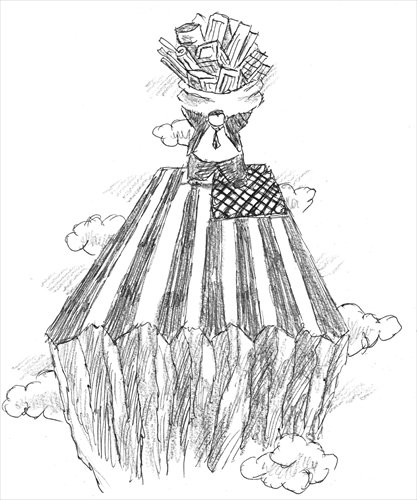HOME >> BUSINESS
China can’t follow Western supply-side reform
By Zha Xianyou and Ding Shouhai Source:Global Times Published: 2016-5-9 23:58:01

Illustration: Peter C. Espina/GT
Supply-side structural reform has become the trendy term for China's economic reforms, and many scholars have attempted to draw on Western economic theories to help draw up a plan for China. The intentions behind this may be good, but China's situation is very different from that of the West and we cannot simply follow suit.
Until now, of the countries that have adopted Western supply-side economics and conducted relevant reforms, only the US, UK and Germany have achieved certain results within a short period of time. The reform measures range from cutting taxation and government expenditure, privatizing State-owned enterprises (SOEs) and deregulating the labor market to reducing government intervention and loosening market access for private firms. So should China follow the same measures in its supply-side structural reforms? The answer clearly is no.
First, China is a socialist country that emphasizes the dominant role of public ownership in the means of production. Regarding some SOEs' low efficiency in certain industries, it should be resolved through methods like mixed-ownership reform, or pushing forward a modern corporate system, and standardizing corporate operations.
Second, despite the great achievements since China's opening-up, China hasn't fully established a sound market mechanism like Western countries, and market failure might occur if we rely purely on the market mechanism to decide resource allocation. In this regard, the government's role cannot be reduced too much, the way it is in the Western world. China's 30 years of successful opening-up has demonstrated that if government intervention proceeds under a standard framework, it can avoid damaging the market mechanism and also offset market failure.
Third, since China's opening-up, the country has focused more on capital and less on labor, which has led to a situation in which labor rights are not well protected. To better protect labor rights, China started to impose regulations on the labor market in 2004, which was conducted much later and executed with less vigor than in Europe. Europe has protected its labor so much for years that some people have been living on their social security, so Europe in fact needs to weaken labor market regulation. Obviously China cannot imitate what Europe does, but should strengthen protection of labor rights.
On the surface, issues like falling growth and earnings at some Chinese SOEs are similar to those faced in Europe, but the inner workings are entirely different. The economic situations in Western countries have been characterized by stagnation, as a result of excessive welfare benefits and over-development of SOEs in capitalist societies. With regard to stagnation, little could be done in supply management, because it couldn't handle the balancing act between stabilizing growth and controlling inflation. So the fundamental purpose of the supply-side reforms in Western countries was to stimulate supply and help the economy out of stagnation.
But China isn't facing stagnation. The risks it faces are increasing debt and deflationary pressure. Rising debt has exacerbated systemic risks in the economy, and deflationary pressure persists, with China's Producer Price Index (PPI) having been in negative territory since March 2012. In China's case, there is unlikely to be a successful outcome if the country simply duplicates measures used by Western economies in their supply-side reforms.
If we have to make a comparison in the supply-side reforms between China and Western countries, we should focus on issues like competition from advanced economies in the process of industrial upgrading, and the fact that China lacks dominance in forming competition rules.
China used to maintain its international competitiveness with labor-intensive products, but as the technological gap with foreign countries has narrowed, there is less space for China to learn from and copy other countries, and the globalization dividend for China in boosting its development is gradually diminishing. So China is in urgent need of pushing its industrial upgrading, and shifting from labor-intensive industries to capital-intensive and technology-intensive industries.
Along with China's industrial transition and upgrading, the country's main sources of competition will shift from developing countries to developed ones. Significant changes in China's competitive landscape have led to different competition rules, but the country lacks dominance in the making of these rules. For instance, developed countries like the US have been attempting to reduce China's competitiveness through amendments to significant principles, such as rules for carbon emissions, intellectual property, and international labor standards.
Internationally, developed economies such as the US are trying to make up for job losses through re-industrialization to resume competitiveness in manufacturing. As competition intensifies, the process of globalization is becoming turbulent as well. On the one hand, multilateral trade negotiations under the WTO framework haven't seen substantial progress; on the other hand, plenty of regional trade arrangements have been introduced - such as the Trans-Pacific Partnership (TPP) - which has led the global market to become fragmented.
In short, China's supply-side structural reforms shouldn't indiscriminately follow Western countries' economic theories and development model. China should adapt its reforms to the latest achievements of the Marxist political economy and adhere to socialism with Chinese characteristics.
The authors are vice president of Renmin University of China, and professor at Renmin University of China, respectively. bizopinion@globaltimes.com.cn
Posted in: Expert assessment